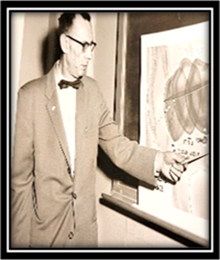Mr. Albert Lee "Gerard" deBey
 Mr. Albert Lee "Gerard" deBey was a renowned scientist and researcher who made significant contributions to the advancement of the Ordnance Corps during World War II and the Cold War era. With 18 years of service at the Ballistics Research Laboratory (BRL), deBey conducted groundbreaking research in ballistics measurement and tracking, preparing ballistic tables for bombs and rockets, and developing orbital tracking systems.
Mr. Albert Lee "Gerard" deBey was a renowned scientist and researcher who made significant contributions to the advancement of the Ordnance Corps during World War II and the Cold War era. With 18 years of service at the Ballistics Research Laboratory (BRL), deBey conducted groundbreaking research in ballistics measurement and tracking, preparing ballistic tables for bombs and rockets, and developing orbital tracking systems.
One of deBey's most notable achievements was the development of the Doppler Velocity and Position (DOVAP) instrumentation system, an early electronic missile-tracking system that tracked the trajectory of guided missiles throughout their flight. This innovative system played a crucial role in the war effort and paved the way for future advancements in missile technology.
After World War II, deBey transitioned to Cold War-era projects, focusing on the space race against the Soviet Union. As the director of the Ballistic Measurements Laboratory, one of the six labs that comprised the Ballistic Research Laboratories, deBey led the development of a long-range tracking system. In response to a directive from the Advanced Research Projects Agency (ARPA) in June 1958, deBey's team successfully installed a three-station complex, including a 50-kilowatt illuminator/transmitter and receiving stations, to track passive satellites passing over a specified area of the US.
Under deBey's leadership, the team achieved remarkable results, detecting and tracking satellites with unprecedented accuracy. The DOPLOC system, which deBey developed, demonstrated the ability to detect, track, and compute reliable orbits within minutes after a single passage of a non-radiating satellite over a single station. This system had the highest discrimination capability against meteors and other extraneous signal sources, making it a crucial asset in the space race.
Although deBey's untimely death in 1960 at the age of 48 prevented him from seeing the full impact of his work, his legacy continued to shape the field of space exploration. The A radio reflection Doppler tracking system, which deBey developed, was used to track satellites that did not emit radio-frequency signals, including Explorer, Tiros, Transit, Lunik, and Pioneer. The DOPLOC tracking method had far-reaching applications, extending to the tracking of projectiles, rockets, guided missiles, and space vehicles.
Throughout his career, deBey demonstrated exceptional technical expertise, innovative thinking, and leadership. His contributions to the Ordnance Corps and the field of space exploration remain significant, and his legacy continues to inspire future generations of scientists and researchers.